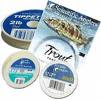A friend emailed me today with questions about fly-fishing leaders. Now, that's a controversial and sometimes difficult subject.
You can differ with me if you want. I don't mind. But I will share with you my leader philosophy.
First, I like to keep it as simple as possible.
I spend most of my fly-fishing time on Sarasota Bay and adjacent water, fly casting for spotted seatrout, redfish, snook, bluefish, Spanish mackerel, pompano and whatever else my be lurking. If I'm targetting trout, I most often use a 6-weight TFO TiCr X with a sinktip line. Simplicity works really well here. For a leader, I use a six-foot length of 20-pound monofilament or fluorocarbon. If the trout are aggressive, I go with mono (it's much cheaper). If they're being picky, I use 6-feet of fluoro (it's nearly invisible under water).
The purpose of a leader is to put invisibility between the fly line and the fly. Leaders can be as short as a foot or two. Or they can be 15 feet of more.
In most applications, 9-foot leaders are common on salt water when using a full, floating line. Many anglers lengthen their leaders when targetting species such as bonefish, tarpon or permit. On my recent trip to Grand Cayman, I used a 12-foot leader while fly fishing for bonefish.
You can buy tapered, knotless leaders, but that can get pricey. Or you can make your own for less than half the cost. I usually make my own. It not only saves money, but also is fun.
For my 12-foot bonefish leaders, I used four feet of 40-pound test, four feet of 20-pound and four feet of 12. I think it's important to construct your leader out of the same material. For my bonefish leaders, I used Mason hard monofilament. It's tough and turns the fly over very well. If you make good, accurate casts, bonefish (especially in the exotic destinations) are not very leader-shy, so mono is feasable.
For some species, you'll have to add a length of heavier mono or fluoro as a shock leader. We use shock to prevent certain species (bluefish, mackerel) from biting through the line. We use shock to prevent other species (snook, tarpon) from wearing through the line.
In fresh water, most of my leaders are about 7 1/2 feet (give or take). When I'm casting small poppers for bluegill, I use 4X tippet (about 6-pound test). You don't want to go too light because the popper will twist lighter line as you cast it. I use monofilament when casting surface flies. Fluorocarbon is actual more dense and will sink some dry flies and poppers. Mono is more buoyant.
When I'm nymphing, I use fluorocarbon becase it's nearly invisible in the water and sinks well. Nymphing is a technique most often used when trout fishing in freshwater streams. But the techneque works very well on Florida warm-water lakes and streams.
I also carry several spools of monofilament and fluorocarbon tippet material. You 7 1/2-foot leader can lose a foot or two after you change flies over the course of the day. Rather than putting on a new leader, you can just add a piece of tippet material to the end of your leader.
For larger poppers, I'll use a 15- or 20-pound leader. To cast these big, air-resistant bugs, you'll need at least a 7-weight rod. You need tackle that's a little beefier because bass love to lurk in some awfully weedy places and around fallen trees. You need a heavier stick just to get them out of the cover.
While leaders are important, they're not the end all. Accurate casts than land softly often make up for leader deficiencies. You can have the most expensive leader you can buy on your line, but it won't do you any good if your casts are off-target or make a lot of noise.
When I'm fly fishing for giant tarpon, I use about nine feet of 20-pound fluorocarbon looped to a short length of 40-pound butt leader. For shock, I use 12 inches of 60- to 100-pound fluorocarbon. I go lighter if the fish are finnicky, spooky or I'm fishing in extremely clear water. I go heavier if the fish are aggressive. I do use a Bimini Twist, whick provides a length of double line and also acts like somewhat of a shock absorber. I've gone as short as six feet for a tarpon leader and as long as 15 feet. For most of my tarpon fishing here along the Gulf Coast, I use a sinktip or intermediate sinking line. Many will telll you and you don't need a long leader when using a sinking line, but I think it can and does make a difference -- especially if the tarpon are nervous.
You can Google leaders and read all about them on the Internet.
Remember, it can be as easy as you want. Or you can make it extremely complicated.
It's your choice.

No comments:
Post a Comment